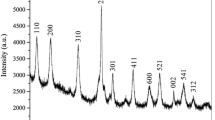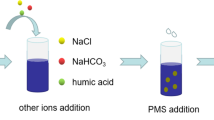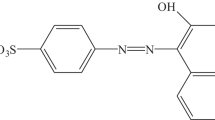Abstract
Transition-metal is known to catalyze peroxymonosulfate (PMS) decomposition to produce sulfate radicals. Here we report reactions between PMS and chloride, without a need of transition metals, also can be used to degrade organic dye pollutant (Rhodamine B, (RhB)). Some important operating parameters, such as dosages of PMS and Cl−, pH of solution, temperature, ionic strength, and several common cations, were systematically investigated. Almost complete decoloration of RhB was achieved within 5 min ([PMS] = 0.5 mM, [Cl−] = 120 mM, and pH 3.0), and RhB bleaching rate increased with the increased dosages of both PMS and chloride ion, following the pseudo-first-order kinetic model. However, the total organic carbon (TOC) removal results demonstrated that the decoloration of RhB was due to the destruction of chromophore rather than complete degradation. RhB decoloration could be significantly accelerated due to the high ionic strength. Increasing of the reaction temperature from 273 K to 333 K was beneficial to the RhB degradation, and the activation energy was determined to be 32.996 kJ/mol. Bleaching rate of RhB with the examined cations increased with the order of NH4 + < Na+ < K+ < Al3+ < Ca2+ < Mg2+. Some major degradation products of RhB were identified by GC-MS. The present study may have active technical implications for the treatment of dyestuff wastewater in practice.




Similar content being viewed by others
References
Adam LC, Gordon G (1999) Hypochlorite ion decomposition: effects of temperature, ionic strength, and chloride ion. Inorg Chem 38:1299–1304
AlHamedi FH, Rauf MA, Ashraf SS (2009) Degradation studies of Rhodamine B in the presence of UV/H2O2. Desalination 239:159–166
Anipsitakis GP, Dionysiou DD, Gonzalez MA (2006) Cobalt-mediated activation of peroxymonosulfate and sulfate radical attack on phenolic compounds. Implications of chloride ions. Environ Sci Technol 40:1000–1007
Beckwith RC, Wang TX, Margerum DW (1996) Equilibrium and kinetics of bromine hydrolysis. Inorg Chem 35:995–1000
Chen J, Zhu L (2007) Heterogeneous UV-Fenton catalytic degradation of dyestuff in water with hydroxyl-Fe pillared bentonite. Catal Today 126:463–470
Church JA (1995) Kinetics of uncatalyzed oxygen evolution from sodium hypochlorite. Ind Eng Chem Res 34:4235–4237
Deborde M, Gunten UV (2008) Reactions of chlorine with inorganic and organic compounds during water treatment-kinetics and mechanisms: a critical review. Water Res 42:13–51
Dong Y, Chen J, Li C, Zhu H (2007) Decoloration of three azo dyes in water by photocatalysis of Fe(III)-oxalate complexes/H2O2 in the presence of inorganic salts. Dyes Pigm 73:261–268
Frank M, Horst E, Klaus JW (1999) Kinetics of the oxidation of hydrogen sulfite by hydrogen peroxide in aqueous solution: ionic strength effects and temperature dependence. Atmos Environ 33:4413–4419
Gerritsen CM, Margerum DW (1990) Non-metal redox kinetics: hypochlorite and hypochlorous acid reactions with cyanide. Inorg Chem 29:2757–2762
Ghodbane H, Hamdaoui O (2010) Decolorization of antraquinonic dye, C.I. Acid Blue 25, in aqueous solution by direct UV irradiation, UV/H2O2 and UV/Fe(II) processes. J Chem Eng 160:226–231
Guillard C, Lachheb H, Houas A, Mohamed K, Elaloui E, Herrmann JM (2003) Influence of chemical structure of dyes, of pH and of inorganic salts on their photocatalytic degradation by TiO2 comparison of the efficiency of powder and supported TiO2. J Photochem Photobiol A: Chem 158:27–36
Hu C, Yu JC, Hao Z, Wong PK (2003) Effect of acidity and inorganic ions on the photocatalytic degradation of different azo dyes. Appl Catal B: Environ 46:35–47
Huang J, Li W, Ren N, Ma F (1997) Disinfection effect of chlorine dioxide on bacteria in water. Water Res 31:607–613
Huang KC, Hoag GE, Chheda P, Woody BA, Dobbs GM (2002) Kinetics and mechanism of oxidation of tetrachloroethylene with permanganate. Chemosphere 46:815–825
Kiwi J, Lopez A, Nadtochenko V (2000) Mechanism and kinetics of the OH-Radical intervention during Fenton oxidation in the presence of a significant amount of radical scavenger (Cl−). Environ Sci Technol 34:2162–2168
Krishna BM, Murthy UN, Kumar MB, Lokesh KS (2010) Electrochemical pretreatment of distillery wastewater using aluminum electrode. J Appl Electrochem 40:663–673
Lachheb H, Puzenat E, Houas A, Ksibi M, Elaloui E, Guillard C, Herrmann JM (2002) Photocatalytic degradation of various types of dye (Alizarin S, Crocein Orange G, Methyl Red, Congo Red, Methylene Blue) in water by UV-irradiated titania. Appl Catal B: Environ 39:75–90
Lu XJ, Yang B, Chen JH, Sun R (2009) Treatment of wastewater containing azo dye reactive brilliant red X-3B using sequential ozonation and upflow biological aerated filter process. J Hazard Mater 161:241–245
Millero FJ, Gonzalez-Davila M, Santana-Casiano JM (1995) Reduction of Fe(III) with sulfite in natural waters. J Geophys Res 100:7235–7244
Muruganandham M, Swaminathan M (2006) TiO2–UV photocatalytic oxidation of Reactive Yellow 14: effect of operational parameters. J Hazard Mater 135:78–86
Muthukumar M, Selvakumar N (2004) Studies on the effect of inorganic salts on decolouration of acid dye effluents by ozonation. Dyes Pigm 62:221–228
Narender N, Srinivasu P, Kulkarni SJ, Raghavan KV (2002) High efficient, para-selective oxychlorination of aromatic compounds using potassium chloride and oxone®. Synth Commun 32:279–286
Paprocki A, dos Santos HS, Hammerschitt ME, Pires M, Azevedo CMN (2010) Ozonation of azo dye acid black 1 under the suppression effect by chloride ion. J Braz Chem Soc 21:452–460
Pinkston KE, Sedlak DL (2004) Transformation of aromatic ether- and amine-containing pharmaceuticals during chlorine disinfection. Environ Sci Technol 38:4019–4025
Ramjaun SN, Yuan RX, Wang ZH, Liu JS (2011) Degradation of reactive dyes by contact glow discharge electrolysis in the presence of Cl− ions: kinetics and AOX formation. Electrochim Acta 58:364–371
Salman Ashraf S, Rauf MA, Alhadrami S (2006) Degradation of methyl Red using Fenton’s reagent and the effect of various salts. Dyes Pigm 69:74–78
Sohrabi MR, Ghavami M (2008) Photocatalytic degradation of direct red 23 dye using UV/TiO2: effect of operational parameters. J Hazard Mater 153:1235–1239
Sun SP, Li CJ, Sun JH, Shi SH, Fan MH, Zhou Q (2009) Decolorization of an azo dye orange G in aqueous solution by Fenton oxidation process: effect of system parameters and kinetic study. J Hazard Mater 161:1052–1057
Wang P, He YL, Huang CH (2011a) Reactions of tetracycline antibiotics with chlorine dioxide and free chlorine. Water Res 45:1838–1846
Wang TX, Margerum DW (1994) Kinetics of reversible chlorine hydrolysis: temperature dependence and general-acid/base-assisted mechanisms. Inorg Chem 33:1050–1055
Wang ZH, Yuan RX, Guo YG, Xu L, Liu JS (2011b) Effects of chloride ions on bleaching of azo dyes by Co2+/oxone regent: kinetic analysis. J Hazard Mater 190:1083–1087
Yu XY, Bao ZC, Barker JR (2004) Free radical reactions involving Cl•, Cl2 −•, and SO4 −• in the 248 nm photolysis of aqueous solutions containing S2O8 2- and Cl− J Phys Chem A 108:295–308
Yuan RX, Ramjaun SN, Wang ZH, Liu JS (2011) Effects of chloride ion on degradation of acid orange 7 by sulfate radical-based advanced oxidation process: implications for formation of chlorinated aromatic compounds. J Hazard Mater 196:173–179
Yuan RX, Ramjaun SN, Wang ZH, Liu JS (2012a) Concentration profiles of chlorine radicals and their significances in · OH-induced dye degradation: kinetic modeling and reaction pathways. Chem Eng J 209:38–45
Yuan RX, Ramjaun SN, Wang ZH, Liu JS (2012b) Photocatalytic degradation and chlorination of azo dye in saline wastewater: kinetics and AOX formation. Chem Eng J 192:171–178
Acknowledgments
The authors would like to acknowledge the financial support from the Fundamental Research funds for Central Universities Central (12D11317) and State Key Laboratory of Pollution Control and Resource Reuse Foundation (No. CRRF11023). This work was partially supported by National Science Foundation of China (Nos. 21007009, 41273108) and “Chen Guang” project (10CG34).
Author information
Authors and Affiliations
Corresponding authors
Additional information
Responsible editor: Philippe Garrigues
Electronic supplementary material
Below is the link to the electronic supplementary material.
ESM 1
(DOC 1106 kb)
Rights and permissions
About this article
Cite this article
Lou, XY., Guo, YG., Xiao, DX. et al. Rapid dye degradation with reactive oxidants generated by chloride-induced peroxymonosulfate activation. Environ Sci Pollut Res 20, 6317–6323 (2013). https://doi.org/10.1007/s11356-013-1678-x
Received:
Accepted:
Published:
Issue Date:
DOI: https://doi.org/10.1007/s11356-013-1678-x




